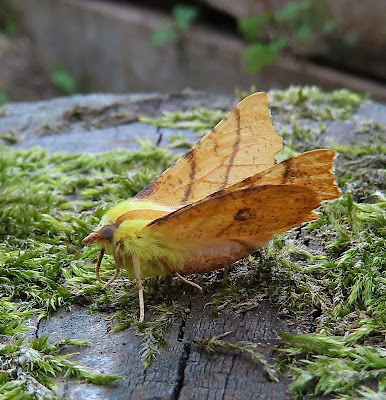Andy Field took this picture of one of the adult cattle egrets in the Reeveshall field on Saturday. Luckily the herd of cows walked closer to the seawall which provided better views of the egrets as they were hard to see in the long grass.
Two common sandpipers were feeding in Maydays creek, photographed by Andy, also a greenshank was seen earlier in the creek.
Also seen along the Maydays seawall were two broods of shelduck - one with nine young, another with 11 ducklings, three great crested grebes, four marsh harriers, red kite, three buzzards, four kestrels, three stonechats and a male yellowhammer.
Jack Hoy saw 25 house martins over the Maydays farmhouse on Saturday.
A Wall Brown fluttered up in front of Andy and I on the Maydays seawall on Saturday, dropping back down for Andy to photograph it. The second Wall Brown on the Island within the week.
Also at Maydays were a painted lady, six-spot burnet moth and a southern migrant hawker dragonfly. A common seal was in the Pyefleet.
A skylark perched on a bush beside the Strood seawall on Friday 26th. A few more waders were along the Strood channel with 300 redshank, greenshank, 80 black-tailed godwits, two whimbrel, 15 curlew, 8 lapwing, 10 oystercatchers, six turnstone and a dunlin. Also seen were 25 Mediterranean gulls, 2 common terns, 3 buzzards, 2 kestrels, 2 sedge warblers, 3 reed warblers, two whitethroats and 24 swifts seen over the houses.
Several gatekeepers on the wing beside the Firs Chase caravan park on Friday. Four brown hares were in the grass field by the Strood.
On Thursday 25th Martin Cock walked the East Mersea seawall near Ivy Dock and saw 80 common terns, Sandwich tern, 20 Mediterranean gulls, 400 redshank including the leucistic one, 15 turnstone, 30 dunlin, 6 black-tailed godwits and 30 linnets on East Mersea Point.
A hobby flew over Feldy View on Thursday, 20 swifts were over the houses, sixty black-tailed godwits and two common terns were by the Dabchicks.
Along the Strood Channel on Wednesday 24th were sixty black-tailed godwits, most still showing their chestnut breeding plumage.
As well as the black-tailed godwits in the Strood on Wednesday, there were 70 redshank, 12 lapwing, two common terns, Mediterranean gull, marsh harrier, buzzard, two reed warblers and a whitethroat, also three brown hares in the grass field.
A Wall Brown was photographed resting on the Strood seawall on Wednesday - quite likely the first ever record for this corner of the Island. It was reasonably faithful to this section of path, flying around for a bit then dropping back down but always quickly closing its wings up!
A male ruddy darter rested on top of the Strood seawall on Wednesday- several others seen on the wing too. A six- spot burnet moth was a nice sight here and also a southern migrant hawker.
At Maydays on Wednesday Martin Cock reported seeing a greenshank, 2 black-tailed godwits, 50 redshank, 10 Mediterranean gulls, marsh harrier, yellowhammer, sedge warbler, four common seals and a painted lady.
Michael Thorley found this group of Limacus flavus slugs feeding on algae in his water butt in his East Mersea garden.
At Cudmore Grove on Tuesday 23rd Andy Field watched 3 willow warblers by the bird hide, barn owl in the box, adult mute swan with six cygnets on the dyke, two sand martins, 59 black-tailed godwits, bar-tailed godwit, one knot, 30 dunlin, 50 turnstones, 100 redshank including the leucistic one, 30 Mediterranean gulls, 33 common terns and two Sandwich terns.
At Reeveshall Andy saw four black-tailed godwits, Mediterranean gull, juvenile marsh harrier and a corn bunting.
Birds noted along the Strood seawall on Tuesday included a red kite drifting west, three marsh harriers, buzzard, two kestrels, stonechat, yellow wagtail, corn bunting, 40 black-tailed godwits, 50 curlew, 12 lapwing, four common terns and fifteen swifts over the houses. Three brown hares were in the grass field.
A young cuckoo was photographed by Rob Lee's sister in their mother's garden in Empress Avenue on Monday 22nd.
Along the Strood on Monday were 70 black-tailed godwits, 170 redshank, four dunlin, two common terns, 12 swallows and a corn bunting singing.
A Marbled White butterfly was a nice surprise on the Strood seawall on Sunday 21st. It flew around several times on one section of the seawall near the sluice, then flew into the nearby field before returning again. It never settled long enough for any photographs- other than this head-on picture. This is only the third island record after the first one in July 2019 at Feldy View and then a second one at Maydays two years ago.
Forty black-tailed godwits were along the Strood on Sunday, also a whimbrel, greenshank, 15 Mediterranean gulls, common tern, four marsh harriers, two buzzards, two stonechats, yellow wagtail, three whitethroats, eight linnets and also 75 swifts over the houses.
Two common sandpipers flew out of the Maydays creek during the high tide period, also four Mediterranean gulls, two great crested grebes, shelduck family with ten young, two sedge warblers, reed warbler, whitethroat and five house martins over the farmhouse.
Also seen on a distant salting up-channel were three common seals each with a pup. Three brown hares were in a Maydays field.


























































